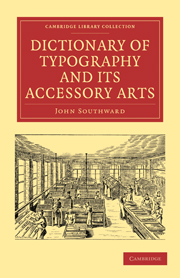Summary
O.—An abbreviation of Overseer. A common phrase in speaking of the overseer is, “the cap. O.”
OBELISK.—See Dagger.
OCTAVO.—A sheet of paper folded into eight leaves, or sixteen pages. Publishers and printers generally style an octavo work as “8vo.”
OCTODECIMO.—A sheet so folded as to make eighteen leaves, or thirty-six pases.
ODD PAGE.—The first, third, and all uneven numbered pages.
ODD FOLIO.—A folio consisting of an uneven number.
OFF.—When a job is said to be off, it is meant that it is duly printed and finished.
OFF-CUT.—Any part of a sheet which is cut off before folding.
OFF ITS FEET.—A forme or line on which the letters do not stand upright.
OIL.—The best oil for presses is neat's foot oil, which does not candy nor become glutinous, as almost all other oils do. On this account it is used in machinery employed in cotton manufactories, where it is necessary to have as little friction as possible.
OLD ENGLISH.—A style of letter used in the early days of printing; it is commonly called. “Black” (q.v.), on account of its darker and heavier appearance than Roman.
OLD-STYLE LETTER.—Roman and Italic letter of the design used previous to the present century, but Which has been re-adopted to a great extent during the last few years.
ON ITS FEET.—When letter stands perfectly upright, it is said to be “on its feet.”
ON TIME.—When a compositor or pressman has a job given to him at so much per hour—such, for instance, as an author's proof or specimen work—he is said to do it “on time.”
- Type
- Chapter
- Information
- Dictionary of Typography and its Accessory Arts , pp. 95 - 98Publisher: Cambridge University PressPrint publication year: 2010First published in: 1875



